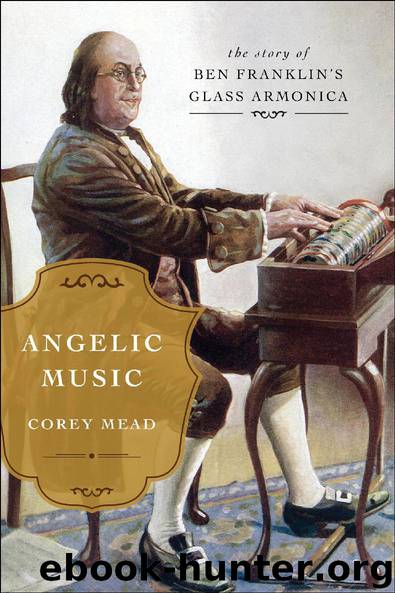Angelic Music by Corey Mead

Author:Corey Mead
Language: eng
Format: epub
Publisher: Simon & Schuster
As we have seen, in the late eighteenth century the glass armonica grew fashionable all throughout Europe. Still, no country embraced it with quite the same passion as Röllig’s and Marianne Kirchgessner’s home base of Germany, where the armonica factory at Karlsruhe produced perhaps the greatest number of instruments. The famous French novelist George Sand mentions this German fervor in her 1856 novel La Comtesse de Rudolstadt, during a scene in which her heroine, Consuelo, first encounters the “magical” instrument’s “vibrant, penetrating quality.” In a remarkable footnote, Sand explains the scene’s origins:
Everyone knows that the armonica created such a sensation with its appearance in Germany, that the imaginations of poets heard in it supernatural voices, evoked by the celebrants of certain mysteries. For some time this instrument, considered magic before it became popular, was raised by the practitioners of German theosophy to the same divine honor as the lyre among the ancients. . . From the armonica they evoked one of the hieroglyphic figures in their mysterious iconography, representing in the form of a fantastic dream. Neophytes in secret societies, hearing it for the first time after the terrors and emotions of their harsh initiations, were so deeply affected by it that several fell into ecstasy. They believed they heard the song of the invisible powers.
The hype that Sand describes in her novel shines through in a song composed by the Bohemian musician F. F. Hurka in 1800, based on words by Richter:
Youngest and fairest of the four daughters of sweet harmony, to whom that mother gave omnipotence in magical sounds, thou, sent to comfort mortals whom the goddess saw lamenting, were turned aside from Elysium and did become—“Harmonika.” When first every ear hearkened to the new sound, all the sons of earth abandoned themselves to enchantment; their intoxicated spirit seemed to hear the harmony of the spheres and the song of the angels in praise of the uncreated.
These magical effects are also described, Röllig-like, in the writings of Prussian novelist E. T. A. Hoffmann. In an 1819 letter, Hoffmann, in the guise of his music critic alter ego, Kapellmeister Johannes Kreisler, tells the story of his acquaintance, Colonel Tetulow Pripop, a man “ totally obsessed” by the armonica. The Colonel spends entire days playing the instrument, wringing from it the “strangest” and most original sounds one can imagine, “distinctive, inimitable” tones that other skilled armonica players only intermittently achieve. The Colonel’s manservant, a happy youth with an “endearingly tigerish physiognomy,” takes such pleasure in his master’s musical stylings that, with loud wails, he throws himself on the ground and kisses the colonel’s feet. The manservant is himself a musical virtuoso, a player of idyllic melodies on his Russian pipe, and he recognizes in his master a kindred soul.
Hoffmann writes of the last time he heard the Colonel play his armonica. Emotionally overwhelmed by his playing, the Colonel had removed his enormous fox-fur hat, and the three caps he wore beneath it. Now he sat at the instrument wearing a
Download
This site does not store any files on its server. We only index and link to content provided by other sites. Please contact the content providers to delete copyright contents if any and email us, we'll remove relevant links or contents immediately.
| Africa | Asia |
| Canadian | Europe |
| Holocaust | Latin America |
| Middle East | United States |
Fanny Burney by Claire Harman(25785)
Empire of the Sikhs by Patwant Singh(22173)
Out of India by Michael Foss(16312)
Leonardo da Vinci by Walter Isaacson(11906)
Small Great Things by Jodi Picoult(6096)
The Six Wives Of Henry VIII (WOMEN IN HISTORY) by Fraser Antonia(4791)
The Wind in My Hair by Masih Alinejad(4425)
The Lonely City by Olivia Laing(4121)
The Crown by Robert Lacey(4105)
A Higher Loyalty: Truth, Lies, and Leadership by James Comey(4034)
The Iron Duke by The Iron Duke(3639)
Millionaire: The Philanderer, Gambler, and Duelist Who Invented Modern Finance by Janet Gleeson(3570)
Sticky Fingers by Joe Hagan(3454)
Alive: The Story of the Andes Survivors by Piers Paul Read(3313)
Papillon (English) by Henri Charrière(3270)
Joan of Arc by Mary Gordon(3260)
Stalin by Stephen Kotkin(3087)
Aleister Crowley: The Biography by Tobias Churton(3021)
Ants Among Elephants by Sujatha Gidla(2925)
